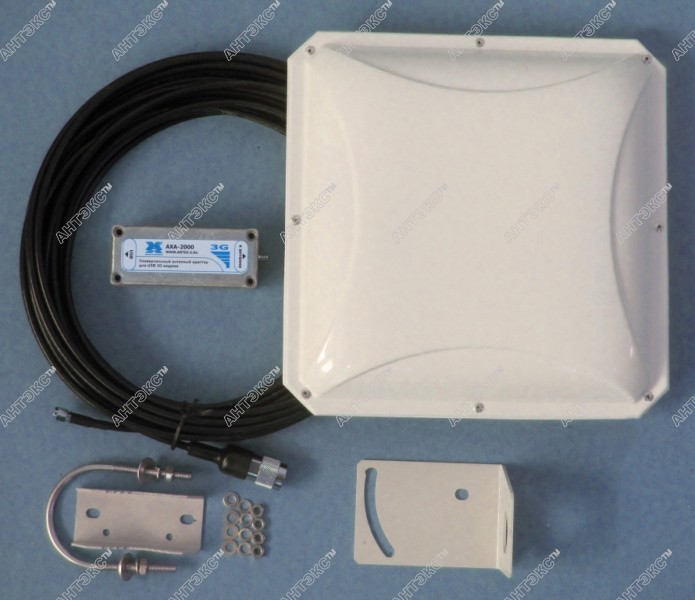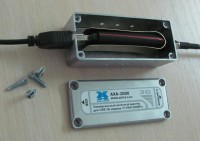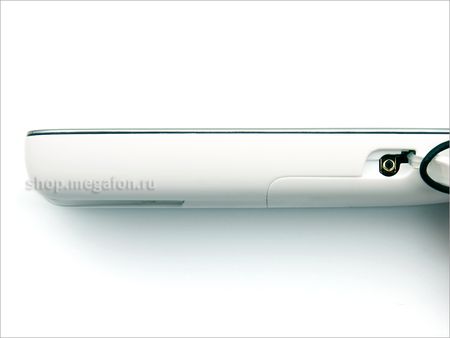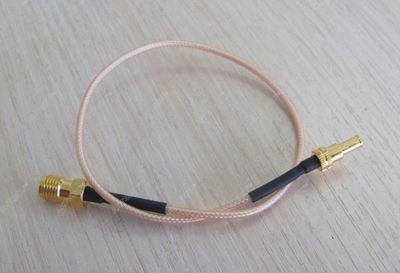Catching the Internet in a remote village using a 3G antenna
Hello to all!
Not so long ago, I set out to provide the Internet for my wife, resting all summer with a child in the village. I even responsibly attended to the purchase of a SIM card for her favorite iPad (they used to do some wi-fi before). What was my disappointment, when on arrival in the village I found an almost complete lack of a cellular network signal on the tablet, on mobile phones ... Clearly, I wasted money for SIM. My week in the village was marked by lasagna in the attics, roofs, just around the site, buried in a smartphone hoping to see at least GPRS. All in vain ... He left for Moscow, mine remained in this wilderness to rest from radio waves.
On the way home I was considering a solution plan. The need for my wife's Internet was dictated not even by many entertaining goals, as well as by the opportunity to correspond on Viber for free and regularly supply me with photos of my daughter (I must say, writing sms and mms from the Tver region to Moscow is not cheap). It also gave hope to the knowledge that in the other village, a couple of kilometers away, the Internet worked, and quite steadily and with an almost complete signal indicator. So somewhere near this village there is a base station supplying the village with a stable 3G signal. Apparently, terrain or other obstacles prevent the signal from reaching our site.
')
The decision was invented of course not new and not original - and a no-brainer that you need to arm yourself with a directional 3G antenna. Moreover, I already had some experience using directional antennas for catching 4G in Moscow. In my head, somewhere in the dusty backyards, there were memories of the course of antenna-feeder devices, which we had been reading at the institute for a semester. And thanks to this knowledge, I was well aware that it would be quite labor-intensive and long to assemble such an antenna on my own, I decided to buy ready-made.
Numerous sites went on sale where various variations of 3G antennas were sold for quite reasonable money. Most of all I liked the products of Anteks firm, I chose “Kit No. 3 for a 3G USB modem (14 dB)”.

It included the antenna itself, a rather small in size (200x200 mm), a 10-meter radio cable and a very funny metal sarcophagus for a modem. The device sarcophagus is extremely simple:

The modem is insulated by the metal walls of the box from extraneous radio waves, the cable is soldered directly to the U-shaped copper plate inside. The whistle itself is installed in this plate, and a slot at the other end of the box is provided for the USB connector. The original adapter, and I believe that it would work fine, but my wonderful Huawei E367, trying to fit in the cramped box, completely broke off the copper plate from the contact. Attempts to solder the plate back were unsuccessful - the fastening reliability was worse than ever.
Very useful on the modem was the antenna CRC9 connector, which allowed me to do without the use of the Anteks adapter.

It remains to buy the appropriate pigtail and you can connect the modem to the antenna directly!

After assembling the antenna, it was necessary to decide how to fasten it and where to send it. Ideally, of course, it would be necessary to put a mast on the roof of the house and raise the antenna to the maximum possible height, but I did not have that much time and necessary materials. To test its capabilities, the attic, where the antenna for satellite TV was already secured, completely fit, and I fixed my 3G antenna to its crown. I sent it approximately to where the neighboring village was located with a stable 3G signal, connected a modem and started testing.
As a result, the signal level varied from about -98dB to -102dB, but most importantly, the modem was connected to the correct base station, and not tossed from one to another due to the narrow-beam lobe of the 3g antenna. It’s no secret that the modem has a built-in omnidirectional antenna, so the base stations in the district constantly compete in the size of the signal in our area, which can be observed by trying to disconnect the modem from the external antenna. Megafon's software confidently showed 3G mode, speedtest measured about 2 Mbit / s at the input and 100 kbits / c at the output.
The result fully met my expectations. I know that it is possible to do better, in our village there are very tall trees and my antenna looks straight at the crown of a mighty aspen, and in front of it came the rowan's rather thick foliage. How many trees there are beyond the direct visibility, I did not even count. But surely, if you raise the antenna above all this vegetation, the result can be very good. Apparently the mast shines for me next summer, but it will be a completely different story.
PS: Unfortunately, there is no possibility to show the original photos of the whole structure, the article was written from memory.
Not so long ago, I set out to provide the Internet for my wife, resting all summer with a child in the village. I even responsibly attended to the purchase of a SIM card for her favorite iPad (they used to do some wi-fi before). What was my disappointment, when on arrival in the village I found an almost complete lack of a cellular network signal on the tablet, on mobile phones ... Clearly, I wasted money for SIM. My week in the village was marked by lasagna in the attics, roofs, just around the site, buried in a smartphone hoping to see at least GPRS. All in vain ... He left for Moscow, mine remained in this wilderness to rest from radio waves.
On the way home I was considering a solution plan. The need for my wife's Internet was dictated not even by many entertaining goals, as well as by the opportunity to correspond on Viber for free and regularly supply me with photos of my daughter (I must say, writing sms and mms from the Tver region to Moscow is not cheap). It also gave hope to the knowledge that in the other village, a couple of kilometers away, the Internet worked, and quite steadily and with an almost complete signal indicator. So somewhere near this village there is a base station supplying the village with a stable 3G signal. Apparently, terrain or other obstacles prevent the signal from reaching our site.
')
The decision was invented of course not new and not original - and a no-brainer that you need to arm yourself with a directional 3G antenna. Moreover, I already had some experience using directional antennas for catching 4G in Moscow. In my head, somewhere in the dusty backyards, there were memories of the course of antenna-feeder devices, which we had been reading at the institute for a semester. And thanks to this knowledge, I was well aware that it would be quite labor-intensive and long to assemble such an antenna on my own, I decided to buy ready-made.
Numerous sites went on sale where various variations of 3G antennas were sold for quite reasonable money. Most of all I liked the products of Anteks firm, I chose “Kit No. 3 for a 3G USB modem (14 dB)”.

It included the antenna itself, a rather small in size (200x200 mm), a 10-meter radio cable and a very funny metal sarcophagus for a modem. The device sarcophagus is extremely simple:

The modem is insulated by the metal walls of the box from extraneous radio waves, the cable is soldered directly to the U-shaped copper plate inside. The whistle itself is installed in this plate, and a slot at the other end of the box is provided for the USB connector. The original adapter, and I believe that it would work fine, but my wonderful Huawei E367, trying to fit in the cramped box, completely broke off the copper plate from the contact. Attempts to solder the plate back were unsuccessful - the fastening reliability was worse than ever.
Very useful on the modem was the antenna CRC9 connector, which allowed me to do without the use of the Anteks adapter.

It remains to buy the appropriate pigtail and you can connect the modem to the antenna directly!

After assembling the antenna, it was necessary to decide how to fasten it and where to send it. Ideally, of course, it would be necessary to put a mast on the roof of the house and raise the antenna to the maximum possible height, but I did not have that much time and necessary materials. To test its capabilities, the attic, where the antenna for satellite TV was already secured, completely fit, and I fixed my 3G antenna to its crown. I sent it approximately to where the neighboring village was located with a stable 3G signal, connected a modem and started testing.
As a result, the signal level varied from about -98dB to -102dB, but most importantly, the modem was connected to the correct base station, and not tossed from one to another due to the narrow-beam lobe of the 3g antenna. It’s no secret that the modem has a built-in omnidirectional antenna, so the base stations in the district constantly compete in the size of the signal in our area, which can be observed by trying to disconnect the modem from the external antenna. Megafon's software confidently showed 3G mode, speedtest measured about 2 Mbit / s at the input and 100 kbits / c at the output.
The result fully met my expectations. I know that it is possible to do better, in our village there are very tall trees and my antenna looks straight at the crown of a mighty aspen, and in front of it came the rowan's rather thick foliage. How many trees there are beyond the direct visibility, I did not even count. But surely, if you raise the antenna above all this vegetation, the result can be very good. Apparently the mast shines for me next summer, but it will be a completely different story.
PS: Unfortunately, there is no possibility to show the original photos of the whole structure, the article was written from memory.
Source: https://habr.com/ru/post/197106/
All Articles